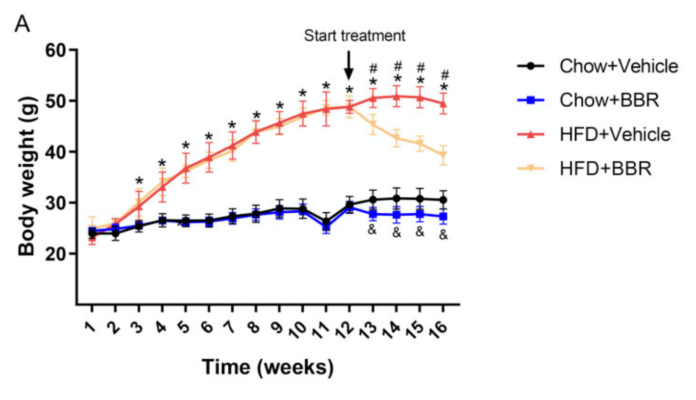This study investigated the effects of Berberine (BBR) supplementation on weight gain, glucose and lipid metabolism, and liver health in obese mice on a high fat diet.
“Recent studies showed that BBR significantly reduced liver steatosis, improved insulin resistance, alleviated glucose and lipid metabolism disorders, and exhibited therapeutic effects on NAFLD in humans and mice.”
Key Points:
Berberine showed numerous benefits for mice on a high fat diet (HFD):
- Weight gain was reversed
- Glucose metabolism & blood lipid profiles were improved in obese mice
- Lipid accumulation in the liver was prevented
- Liver health was maintained by increasing the levels of SIRT1
- NAD+ levels were increased in the liver
Animal Study Evaluates the Effects of Berberine Supplementation in Obese Mice.
The mice were divided into two initial groups. One was fed a standard chow diet and one was fed a high fat diet (HFD) for 12 weeks.
After 12 weeks, mice from each group were randomly classified into two subgroups, and were supplemented with either Berberine (BBR group; 200 mg/kg Berberine) or Vehicle (control group; equal volume of 0.5% methylcellulose) daily for 4 weeks.
Body weight was monitored weekly.

Berberine Reversed Weight Gain in Mice Consuming a HFD
Starting at 3 weeks on a high fat diet (HFD), mice in the HFD group showed significantly greater weekly weight gain than mice fed a standard diet.
“Moreover, compared with the HFD + Vehicle group, BBR treatment significantly lowered the body weight of mice.”

Mice in the HFD + BBR group (yellow line) showed a significant decrease in body weight after starting Berberine supplementation, while mice in the HFD + Vehicle group (Control group; orange line) continued to gain weight throughout the experiment.
Mice fed a standard chow diet with or without Berberine supplementation (represented by the blue and black lines, respectively) maintained a steady weight throughout the experiment.
Glucose Metabolism & Blood Lipid Profiles Were Improved in Obese Mice
“HFD elevated the fasting blood glucose in mice and BBR treatment reduced the abnormal fasting blood glucose.”
Fasting blood glucose indicates how well the body is able to use the food we eat for energy. High levels of fasting blood glucose can be a sign of metabolic disease


Red bar: represents the mice fed a high fat diet (HFD) without Berberine. Their fasting blood glucose levels were significantly increased.
Yellow bar: represents the mice fed a HFD with Berberine (HFD + BBR). Their fasting blood glucose levels were significantly lower than the mice fed a HFD without Berberine (red bar).
Blue bar: represents the mice fed a standard chow diet with Berberine (Chow + BBR). Their fasting blood glucose levels were similar to the mice fed a standard chow diet without Berberine supplementation (black bar).
Black bar: represents the mice fed a standard chow diet (Chow + Vehicle) and without Berberine.
“To investigate the effect of BBR on dyslipidemia induced by HFD, the blood lipid profile was measured.”
Dyslipidemia is high cholesterol or fats (lipids) in the blood.
The HFD significantly increased serum triglycerides, total cholesterol, LDL-C, and HDL-C levels. However, supplementation with Berberine during the HFD feeding significantly reduced serum triglycerides, total cholesterol, and LDL-C levels, while HDL-C levels did not change).
“The results showed that BBR improved the glucose and lipid metabolism disorders induced by HFD in mice.”
Berberine Protected Against Lipid Accumulation in the Liver of Mice Consuming a HFD
Berberine supplementation in mice fed a high fat diet (HFD-BBR group) significantly reduced the accumulation of lipids in the liver, the weight of the liver, and the liver-to-body ratio, compared to mice fed a HFD without Berberine (HFD-Vehicle).
Liver lipid accumulation is an early onset process of non-alcoholic fatty liver disease (NAFLD), which occurs when excess fats build up in your liver.

The pale color observed in the livers of mice in the HFD + Vehicle group is a sign of lipid accumulation. Notice that Berberine supplementation protected mice consuming a HFD (HFD + BBR) from lipid accumulation, resulting in liver coloration and size similar to that of mice on a standard chow diet.
Berberine Raised NAD+ Levels in the Liver
Berberine supplementation increased NAD+ levels in the liver (blue bar) and was shown to increase activity of CPT1A (figure D), an enzyme that plays a significant role in controlling lipid metabolism and energy homeostasis.

The regulation of lipid metabolism and energy homeostasis is essential for maintaining a healthy body weight and providing energy for various bodily functions. Imbalances in these processes can contribute to conditions such as obesity, metabolic disorders, and energy deficiencies.
Berberine Maintained Liver Health by Increasing the Levels of SIRT1
The researchers next investigated how Berberine helps protect the liver from lipid accumulation after a high fat diet (HFD).
They found that Berberine significantly increased the levels of SIRT1, an important molecule in the body that regulates metabolism and has been shown to protect liver health.

The HFD significantly reduced the levels of SIRT1 (red bar). However, when mice were supplemented with Berberine with their HFD, the levels of SIRT1 were significantly increased (yellow bar).
Berberine also increased the levels of SIRT1 in the absence of a HFD (Chow + BBR, blue bar), compared to mice given a standard chow diet (black bar).
Interestingly, the beneficial effects of Resveratrol and NMN, two other natural compounds with potential anti-aging and disease-fighting properties, have also been shown to be mediated by SIRT1.
Conclusion
This study showed that Berberine protected against obesity, improved glucose and lipid metabolism, increased NAD+ levels in the liver, while reducing lipid accumulation in the liver. The researchers found that Berberine exerted its beneficial effects on the liver through increasing the levels of SIRT1. These findings suggest Berberine may be a potential treatment option for obesity and associated metabolic disorders.
“Berberine treatment attenuated hepatic steatosis, reduced triglyceride and cholesterol concentration in the liver, and improved lipid and glucose metabolism disorders compared with the HFD group.”


Two questions: 1) What dose of berberine, say in mg/kg or however it is measured, were the mice given; and 2) was it liposomal?
Oh, I just read the study, and the mice were given 200mg/kg once a day. Was it liposomal BBR? I ask because BBR is about 1% bioavailable when given orally, meaning the mice were effectively taking up about 2mg/kg every day. In my own case I weigh 90kg, so if I am taking liposomal BBR, I think I should take somewhere around 180mg daily, or maybe a little more since even liposomal is not 100 bioavailable. Am I thinking about this correctly?